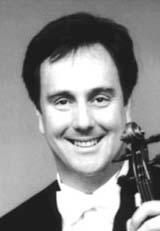Opera Lafayette at Hillwood
 Ryan Brown is a man of prodigious talents. I know him as the founder and conductor of Washington's leading French Baroque performing group, Opera Lafayette, and its instrumental counterpart, the Violins of Lafayette. However, Brown is also a violinist himself, and it was in that role, as well as that of lecturer and master of ceremonies, that we saw him at the first Opera Lafayette concert of the season on Saturday afternoon (October 1). For several years, Opera Lafayette has partnered with the Hillwood Museum and Gardens, because the owner of that estate, turned into a museum after her death, was Marjorie Merriweather Post.
Ryan Brown is a man of prodigious talents. I know him as the founder and conductor of Washington's leading French Baroque performing group, Opera Lafayette, and its instrumental counterpart, the Violins of Lafayette. However, Brown is also a violinist himself, and it was in that role, as well as that of lecturer and master of ceremonies, that we saw him at the first Opera Lafayette concert of the season on Saturday afternoon (October 1). For several years, Opera Lafayette has partnered with the Hillwood Museum and Gardens, because the owner of that estate, turned into a museum after her death, was Marjorie Merriweather Post.
Mrs. Post, heiress to the Post cereal fortune, was a major supporter of the arts, giving lots of money to the National Symphony Orchestra, for example. As a collector, she was interested in decorative art objects, primarily things from Russia and porcelain and other precious objects from Baroque France. The grounds are perhaps the most desireable plot of land in the District of Columbia, not unlike the Bliss's home at Dumbarton Oaks, which also has its extensive garden joined to the idyllic land of Rock Creek Park, that immense green space that divides the northern part of the city. One of the dependant buildings near Mrs. Post's mansion is the Adirondack Building, a sort of natural wood Nordic-style A-frame lodge. It provided the perfect venue for Opera Lafayette's chamber group - four strings, harpsichord, and two voices.
The one-hour program was devoted to two composers, Jean-Philippe Rameau (1683-1764) and Wolfgang Amadeus Mozart (1756-1791), whose lives briefly overlapped and whose music together forms a bridge between the Baroque and Classical styles. Tenor Tony Boutté performed three excerpts from Rameau's Platée (premiered in 1745 at Versailles, for the Dauphin's marriage to Maria Teresa of Spain), a rather strange opera about a frog princess who is seduced by Zeus. You may recall that New York City Opera produced this opera in 2000 and revived it in 2004, in conjunction with Mark Morris Dance Group and costume designer Isaac Mizrahi. (See links to some reviews here.) In that production, Jean-Paul Fouchécourt performed the title role, a marvelous singer who will provide the vocal part of Opera Lafayette's February 12 concert this winter, a program of Rameau arias.
Sacchini's Œdipe à Colone (May 15, 2005) Lully's Acis et Galatée (February 22, 2005) Opera Lafayette (January 23, 2005) |
Ryan Brown explained each of the three Rameau excerpts, playing with the other musicians short pieces of the accompaniment to demonstrate how the text was characterized in the music. Tony Boutté camped his way down from the building's balcony during the ritournelle of "Que ce séjour est agréable" (Act I, scene 3). In "Quittez, nymphes, quittez" (Act I, scene 5), he was splendidly accurate on the many runs (depicting Juno's supposed weeping). In previous performances in the much larger Clarice Smith Center, his voice has been on the small side, but the smaller Adirondack Building was a perfect venue for him. In his final excerpt, "A l'aspect de ce nuage" (Act II, scene 3), poor Platée watches Zeus appear and go through several transformations (a donkey, an owl, and finally his real shape). In this dramatic recitative, the animal transformations (neither of which, I can't help but think, would be very pleasant to couple with, even for a frog princess) are set with funny descriptive music.
The other half of the program was a look forward to Opera Lafayette's spring concert, a full concert performance of Mozart's Idomeneo, an early opera seria premiered at the Munich Hoftheater in 1781, on June 2 and 3, 2006. Soprano Millicent Scarlett, who will perform the role of Elettra in that concert, gave us two brief excerpts. Her rich, dark voice made a large, nearly overwhelming sound for the small room, which leads me to believe that we will be able to hear her just fine at Clarice Smith. That performance will be in cooperation with Catherine Turocy's New York Baroque Dance Company. The composer may have been Austrian, and the text may be in Italian, but the libretto is adapted from Campra's opera Idoménée and shows the influence of Gluck and Piccinni's French operas.





















































1 comment:
Millicent Scarlett, "Googled":
"Canadian soprano Millicent Scarlett hails from Winnipeg, Manitoba. She received her Bachelor of Music in Voice Performance from Brandon University in Canada. While at Brandon she received the silver medal, rarely awarded for the highest GPA in the Applied Music Performance degree. From there she attended University of Maryland College Park, where she received her Master of Music in Opera. She also holds a certificate of study from the Mozarteum in Salzburg, Austria. ..."
Post a Comment